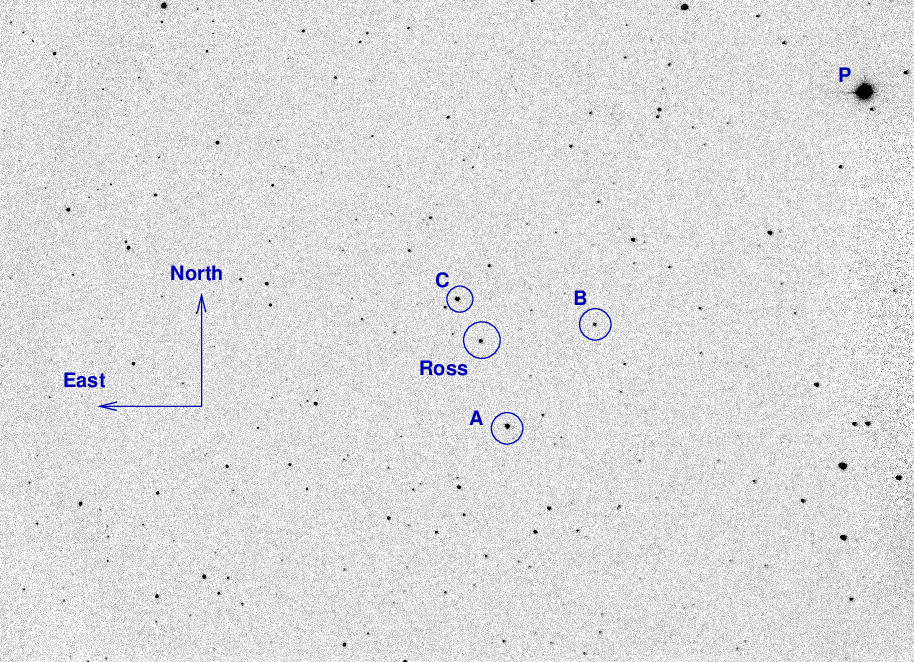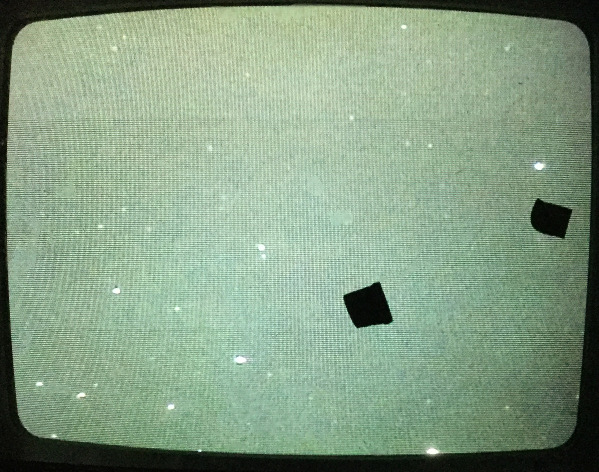
On the night of Aug 20/21, 2020, under good conditions, I acquired some decent images of Nova Cas 2020; for this, my second attempt, I used longer exposure times, and made measurements that have a relatively small internal scatter.
I also acquired images of Ross 248 and GX And for our continuing study of their parallax and proper motion -- in R-band only.
You can find some basic information on this star at the the AAVSO's Alert Notice page for it.
The main setup was:
Notes from the night:
The object is at
RA = 00:11:42.97 Dec = +66:11:19.0 (J2000)
A chart of the field based on pictures tonight is shown below. The size of the chart is about 38 x 26 arcminutes.

The table below is from the AAVSO; see their full table with more information. You might also look at

I used the star labelled A = "87" to calibrate my V-band measurements; based on two other stars, the calibration is good to about 0.05 mag, though I didn't include any color terms.
Here's a picture of the TV with the finder's field of view when pointing at Nova Cas 2020:

The text file below shows my results.
# Measurements of N_Cas_2020 made at RIT Obs, UT 2020 Aug 21, # in good conditions, # by Michael Richmond, # using Meade 12-inch LX200 and ATIK 11000. # Exposures 20 seconds long, V filter. # Tabulated times are midexposure (FITS header time - half exposure length) # and accurate only to +/- 1 second (??). # 'mag' is a differential magnitude based on ensemble photometry # using a circular aperture of radius 4 pix = 5.0 arcseconds. # which has been shifted so AAVSO 000-BNP-448 has mag=8.711 # which is its V-band magnitude according to AAVSO. # # UT_day JD HJD mag uncert Aug21.34931 2459082.84931 2459082.85015 11.995 0.010 Aug21.34964 2459082.84964 2459082.85048 11.993 0.010 Aug21.34999 2459082.84999 2459082.85083 12.005 0.010 Aug21.35032 2459082.85032 2459082.85116 11.974 0.010 Aug21.35067 2459082.85067 2459082.85151 11.982 0.010 Aug21.35102 2459082.85102 2459082.85186 11.999 0.010 Aug21.35135 2459082.85135 2459082.85219 11.979 0.010 Aug21.35170 2459082.85170 2459082.85254 11.992 0.010 Aug21.35204 2459082.85204 2459082.85288 11.986 0.010 Aug21.35238 2459082.85238 2459082.85322 11.972 0.010 Aug21.35273 2459082.85273 2459082.85357 11.973 0.010 Aug21.35307 2459082.85307 2459082.85391 11.980 0.010 Aug21.35341 2459082.85341 2459082.85425 11.974 0.010 Aug21.35375 2459082.85375 2459082.85459 11.985 0.010 Aug21.35410 2459082.85410 2459082.85494 11.973 0.010 Aug21.35443 2459082.85443 2459082.85527 11.980 0.010 Aug21.35478 2459082.85478 2459082.85562 11.984 0.010 Aug21.35513 2459082.85513 2459082.85597 12.002 0.010 Aug21.35546 2459082.85546 2459082.85630 11.979 0.010 Aug21.35581 2459082.85581 2459082.85665 11.984 0.010
This is one of the stars that a capstone student may study over the next year in a project involving parallax. Ross 248 is a relatively faint red star surrounded by many other stars of similar brightness, so it's a good candidate for high-precision parallax measurements.
These observations involved:
The object is (currently) near position
RA = 23:41:55.27 Dec = +44:10:06.38 (J2000)
A chart of the field is shown below. The size of the chart is about 41 x 27 arcminutes. The noisy area at right (West) is the shadow of the guider's pickoff mirror.

I've marked the location of several comparison stars.
star UCAC4 B V r ------------------------------------------------------------------------- A UCAC4 671-120730 12.617 10.689 B UCAC4 671-120688 C UCAC4 671-120749 10.987 10.663 P kappa And 4.06 4.14 --------------------------------------------------------------------------
I took a photo of the finder TV's screen when pointing to Ross 248; this could be a useful reference for the future:

The dark current was normal this evening:

Tonight was interesting, due to a small mistake. I took a series of 38 (initially supposed to be 50) exposures of Ross 248, then realized that I had not focused the telescope! I paused, checked the focus, and after taking short images with slightly larger and slightly smaller (in steps of 0.010 to 0.020 inches) focus positions, found that the best focus was just one step away from the original position. So, I then took a set of 30 more images with this slightly modified focus position.
When I analyzed the images later, I discovered that the positions of Ross 248 in the early set was slightly different in RA (though the same in Dec) than the positions in the later set of images. The two clumps of positions overlapped only slightly, by around 1/3 of the size of each clump. The mean RA was 41 mas larger in the post-focus images, while the stdev of each set from its own mean was close to 30 mas. In other words, there was a marginally statistically significant shift in RA.
Huh.
The sky value shows that the sky was mostly clear, with a brief bump due to some light cloud.

The number of objects detected.

I used an aperture with radius 4.0 pixels tonight, as usual.

This is my thirteenth measurement of Ross 248. The motion is starting to show clearly, negative in both RA and Dec.

Like Ross 248, GX And is a nearby (binary) star which will be the target of a parallax project in the coming year. One of the two components is bright -- about mag V = 8 -- so one must use short exposures to prevent it from saturating the detector. That may mean that this system isn't as easy to measure as Ross 248 or some others.
The object is currently close to this position:
RA = 00:18:28.4 Dec = +44:01:31 (J2000)
but it does have a very high proper motion.
A chart of the field is shown below. The size of the chart is about 41 x 27 arcminutes. The noisy area at right (West) is the shadow of the guider's pickoff mirror.

The two components of the GX And binary sit inside the box. I've marked the location of several comparison stars as well.
star UCAC4 B V r ----------------------------------------------------------- A 671-001473 9.939 9.790 B 670-001639 9.413 8.472 C 671-001509 12.712 11.421 11.001 -----------------------------------------------------------
I took a photo of the finder TV's screen when pointing to GX And; this could be a useful reference for the future:

I took two series of 50 exposures of the field in R-band, using exposure times of 5 seconds.
Using the same techniques as described for earlier nights, I matched detected stellar positions to the Gaia DR2 catalog.
The target is clearly moving in the positive RA and Dec directions, as we would expect from its known (large) proper motion.

Last modified 8/06/2020 by MWR.